Cars with big diesel engines may be in the news for all the wrong reasons but the two models you see here are as far away from the controversies as can be. While it helps that they are not luxury cars by any stretch of the imagination, what is keeping and will keep the unwanted attention off them is that they run amongst the smallest and most efficient diesel engines in the business.
The Maruti Celerio is actually a record holder in this regard. Its twin-cylinder, 0.8-litre turbo-diesel unit is the smallest passenger car diesel engine in India and its ARAI-tested fuel economy of 27.62kpl, the best among all small cars. Tata’s latest three-cylinder, 1.05-litre turbo-diesel engine that debuts on the new Tiago is not a whole lot larger as engines go and here the Tiago delivers a very close 27.28kpl in the Indian Driving Cycle.
In essence, these are cars tailor-made for those looking at low running costs. But which one offers the more complete package? Read on.
Look around
We won’t go too deep into the subjective issue of design and styling but we think you’ll agree when we say the Tiago has the more appealing form. The well-proportioned Tata looks fresh and chic, and a whole lot more interesting than the Celerio that looks almost nondescript in comparison. This holds true for their cabins as well.
Tata has outdone itself by giving the Tiago a cabin that wouldn’t seem out of place on a more expensive car. The dashboard is smartly laid out but it’s really the quality of materials that makes the cabin feel special. The textured finish to the dash, the rich seat fabrics, the roof lining and even the damped operation of the glovebox lid lend this space a premium ambience. It’s well thought out too. Outside visibility is good and there’s lots of space to store odds and ends.

Count the number of storage spaces and you’ll find the Celerio’s cabin closely matches the Tiago’s in practicality. But, it’s a level or two down on design and execution. Sure, the two-tone theme adds colour in the cabin but material quality is nowhere near as nice as the Tata. Again, where the simple dashboard places the important controls within easy reach and even houses the high-set gear lever, it looks staid and unremarkable.
The Celerio’s front seats, with their fixed headrests, don’t appear special either but they do offer good comfort. The rear seat is comfortable and supportive too but where it makes a mark is in terms of space. Legroom is really impressive and there’s more than adequate headroom as well. The large windows further help the airy feeling inside. Maruti designers have really made the most of the Celerio’s small footprint.
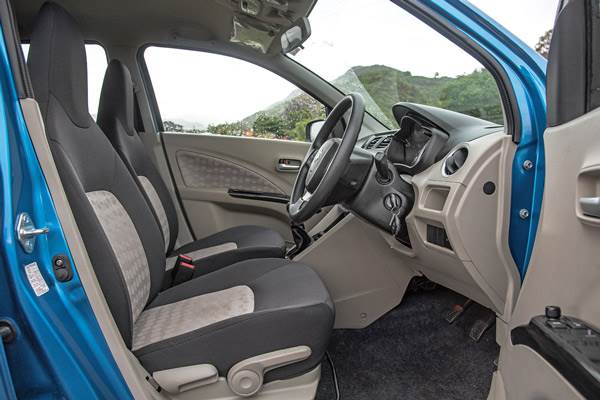
The Tiago’s cabin is roomy in its own right but there’s no missing it’s got the smaller rear windows and less rear leg- and headroom. Some might find the rear seat backrest a touch too reclined too. Up front, drivers will like the inclusion of a dead pedal but the somewhat lack of thigh and shoulder support could be bothersome over long journeys.
Eye on the feature
Power windows, electric mirror adjust, height-adjustable driver’s seats, steering-mounted
audio controls, audio systems with USB, aux-in and Bluetooth for music streaming and telephone functions are some of the features you can expect on the top-spec versions of both these cars. However, the Tiago goes one up on the Celerio with its more comprehensive sound system which includes four speakers plus four tweeters. The Tiago’s infotainment system can also be hooked up to your smartphone to relay sat-nav instructions. Rear parking sensors and a cooled glovebox are some of the other features exclusive to the Tiago. The Celerio does offer the versatility of a split rear seat though.
In terms of safety, the top versions of both cars get dual airbags and ABS, though neither car offers the protection of adjustable rear headrests.
Every cc counts
Small engines are good for fuel economy, not so much for power and performance. In this respect, the Celerio seemingly enters the competition with a big disadvantage. Its two-pot motor churns out just 47.6hp though peak torque is an acceptable 124.5Nm. The Tiago’s larger three-cylinder mill, on the other hand, makes a far more respectable 70hp and 140.2Nm. No prizes for guessing
which car has the edge in flat-out performance. Where the Tiago does the 0-100kph dash in
17.52 seconds, the Celerio takes a yawn-inducing 22.66 seconds. And thanks to the way they are geared, the Celerio will also max out at just 138kph where the Tiago will pull to 161kph.
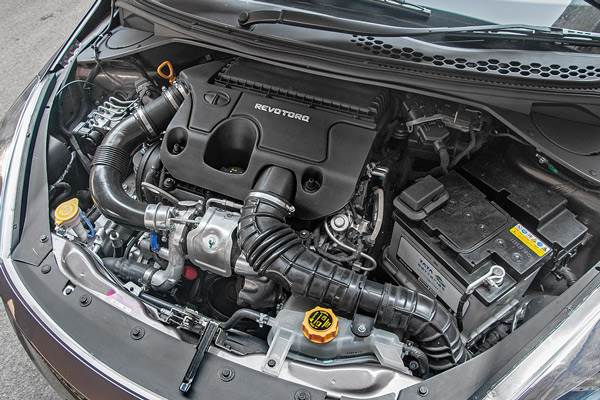
But, don’t write off the Celerio just yet. Weighing in at 900kg, it’s a full 180kg lighter than the Tiago diesel. Correspondingly, it has the more favourable torque-to-weight ratio, the benefit of which you can experience on the move. So long as you are in the right gear for a particular speed, it feels more responsive to throttle inputs than the Tiago (even with the Tata in City mode). The Celerio’s better in-gear performance figures reflect this too. However, the Celerio’s engine gives you a very narrow powerband to operate in, so driveability takes a hit when revs are outside the 1,800-3,200rpm zone. The clutch is light but gearshifts call for a firm shove.
Where the Celerio simply disappoints is in refinement. While low rpm vibrations are reasonably well contained, the engine sounds like it belongs to a run-down tempo. In fact, the engine note is one of the things that has kept buyers away from the Celerio diesel. The Tiago’s three-cylinder engine, in comparison, runs a lot quieter and the more generous sound deadening on the body helps too. It does sound coarse when revved hard but it’s nowhere near as noisy as the Celerio.
Drive at ton-up speeds or just uphill and you’ll also find the Tiago has the legs on the Celerio. There’s adequate pulling power from 1,500rpm on and this reduces the need to work the occasionally notchy gearbox and short-travel clutch. Still, the mid-range is where it’s at and where you’d need the engine spinning for a quick overtaking move.
Road rollers
Drive the Tiago and the Celerio on the same roads and you’ll notice subtle differences in how they tackle surface imperfections. The Celerio has the flatter high-speed ride but feels that little bit firmer over the rough stuff at low speeds. The Tiago, on the other hand, rounds off the bumps better but is also more susceptible to vertical movements at speed. Still, it’s the Tiago that feels more sure-footed at all times with a likeable big-car heft in the manner it drives. The Tiago has the nicer steering too. True, it’s devoid of feel at the straight-ahead position but it’s generally better weighted than the Celerio’s steering which can feel a tad heavy at slow speeds. The Celerio’s steering also doesn’t self-centre sufficiently and this is an irritant. In the corners, the Celerio comes across as an easy handler but higher grip levels and the sportier dynamics means the Tiago is the car that you’ll enjoy more.
Oil burning question
With class-leading fuel economy, incredibly low running costs and that reassurance you only get from buying a Maruti, the Celerio diesel should have rocked the market. Things, however, haven’t panned out that way. The Celerio’s mediocre refinement has been its biggest impediment in achieving mass acceptance. Performance is adequate for city use but there’s little on offer for high mileage users who are likely to frequent the highway. The Celerio diesel scores decently on other parameters but it’s not a car that will top anyone’s wishlist.
Quite to the contrary is the Tiago that brings in a degree of desirability. It’s attractively styled, comes with a well-finished interior and promises to come loaded with features. The engine isn’t the liveliest around but the overall driving experience makes up for the lack of pep. In fact, if you see the Tiago in entirety, you’ll find it has more going for it than against it. Additionally, Tata has priced the Tiago diesel range from Rs 3.94-5.54 lakh (ex-showroom, Delhi), successfully undercutting comparable Celerios, which makes the new Tata a tremendous value proposition. Although these prices are introductory and could go up later, it seems Tata has learnt a lesson from the Bolt's pricing strategy (widely perceived as on the higher side). So, with the new Tiago, the budget end of the diesel hatchback segment is Tata’s for the taking.
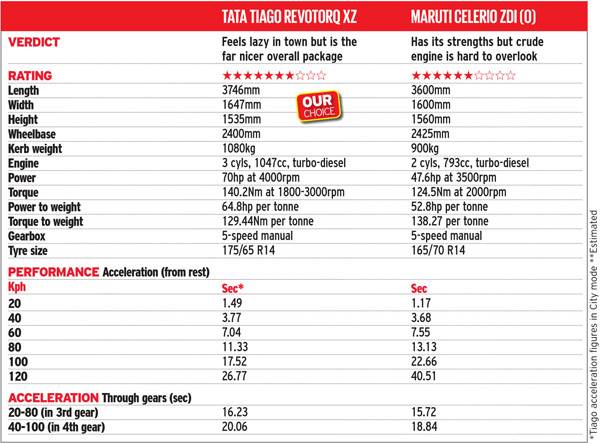
| Tata Tiago vs diesel rivals prices (ex-showroom, Delhi) | |||
|---|---|---|---|
| Tata Tiago | Maruti Celerio | Hyundai i10 | Chevrolet Beat |
| XB - Rs 3.94 lakh | LDI - Rs 4.82 lakh | --- | Base - Rs 5.27 lakh |
| XE - Rs 4.29 lakh | VDI - Rs 5.12 lakh | --- | LS - Rs 5.62 lakh |
| XM - Rs 4.69 lakh | ZDI - Rs 5.43 lakh | --- | LT - Rs 5.93 lakh |
| XT - Rs 4.99 lakh | ZDI(O) - Rs 5.90 lakh | --- | LTZ - Rs 6.57 lakh |
| XZ - Rs 5.54 lakh | --- | --- | --- |
| Tata Tiago vs diesel rivals prices (ex-showroom, Mumbai) | |||
|---|---|---|---|
| Tata Tiago | Maruti Celerio | Hyundai i10 | Chevrolet Beat |
| XB - Rs 4.18 lakh | LDI - Rs 4.81 lakh | --- | Base - Rs 5.53 lakh |
| XE - Rs 4.55 lakh | VDI - Rs 5.12 lakh | --- | LS - Rs 5.90 lakh |
| XM - Rs 4.96 lakh | ZDI - Rs 5.43 lakh | --- | LT - Rs 6.28 lakh |
| XT - Rs 5.27 lakh | ZDI(O) - Rs 5.90 lakh | --- | LTZ - Rs 6.90 lakh |
| XZ - Rs 5.84 lakh | --- | --- | --- |
Click here to see all prices of the Tiago


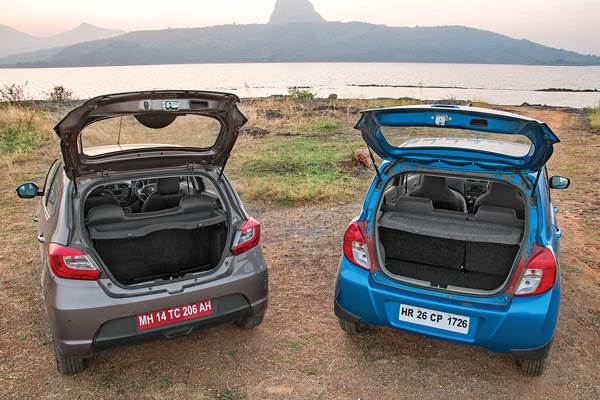
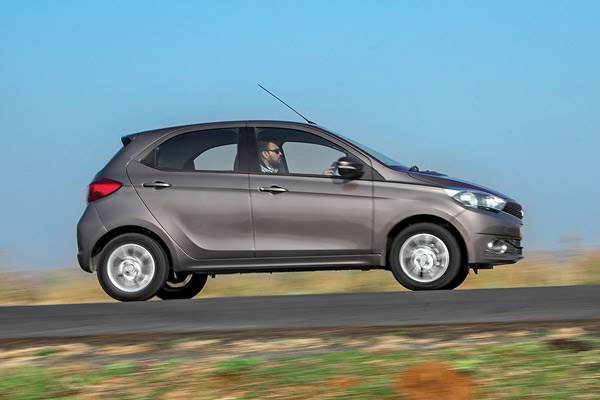
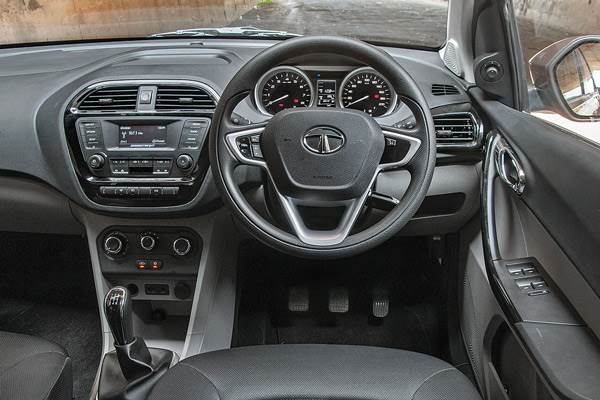


Comments
Member Login
Personal Details
No comments yet. Be the first to comment.